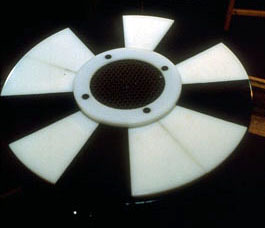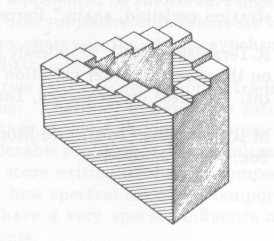
The keyboard at the exhibit.
Believe none of what you hear.
Here is the Snack version of this exhibit available on-line Find the Highest Note.

To Do and Notice
What do you hear?
This exhibit presents an acoustic illusion.
It shows that to study the world we have to understand perception for
all of our senses.
The instructions seem easy enough, Find the highest note.
I begin by playing the notes one after the other clockwise around the
circular keyboard.
After I go around twice people begin to smile. They realize that they are hearing an acoustical illusion.
I ask "What do you hear?" a variation on my usual question.
Someone answers,"the pitch of each note seems higher than the previous one. The pitch seems to go up and up as you go around the keyboard."
I have a simple question for you
I then say,
"I have a simple question for you."
This is a warning that the question I am about to ask has no simple
correct answer.
"Let's look at just two keys."
I then say I am going to play a white key and a black key, and ask which has the higher pitch.
Find a white key between two black keys. Play the white key and then the black key next to it, clockwise around the circle. Almost everyone hears that the white key is higher in pitch than the black key. The order the keys are played doesn't matter, white followed by black or vice-versa.
Then I choose a black key and a white key on opposite sides of the circle, i.e. on opposite ends of a diameter. I play a white key first and then a black key. Many people say that the white key is higher in pitch, many say the black key is higher, a few say they cannot tell which is higher. Then I reverse the order playing the black key first and then the white key, a few people change their answers. The people look at each other realizing that even though they heard the same sounds, their perceptions of the sounds were different.
This is an important lesson for them to learn as they approach science.
Now ask for questions and experiments
For example:
Star at your white key and play around the circle of notes clockwise each note increases in pitch as you go until you come to the black key straight across the diameter. Then start again and go counterclockwise. Each note decreases in pitch. Both paths take you to the same note. Yet the same note may sound different depending on the path you took to reach it.
What's Going On?

The "note" produced when you press a key is a actually a chord. When you play the "C" key, several C notes are played over 6 different octaves. Each of the component notes is played at a different volume - the notes in the middle octaves are the loudest. If you move around the keyboard clockwise from one key to the next, you and almost everyone else will hear a note that increases in pitch. Each of the 6 different notes which makes up the chord of this second key is slightly higher in frequency than the component tones of the C chord. As you move clockwise around the keyboard each note sounds higher than its neighbor.
When you go around one complete octave of 12 keys you return to the original chord. Each note sounded higher than the one before but you come back to the same place. This is an acoustical illusion.
If you go around the keys in the opposite direction, each note has a lower pitch than the one before until you arrive back at the starting note.
The particular chords across the diameter of the circle of keys are separated by a half of an octave, a tritone. One person will perceive one of these notes as being higher than the other, another person may perceive a different answer. Each note in the cord has been shifted to exactly midway between the notes in the original chord.
Click here to see the names of the notes played at this exhibit.
So What?
Human perception of pitch is complicated. The particular combination of tones in each chord has been chosen to produce a strong acoustic illusion. It is hypothesized that individuals will tend to evaluate the pitches of these notes based on the tonal range of their native dialect.
Etc.
These notes are known as a Shepard tones.
Exploratorium exhibit builder Jim Meador designed and built the
original museum exhibit. In his going away lecture at the
Exploratorium, Jim pointed out the importance of the names of
exhibits. He singled out "Find the Highest Note" as an exhibit with a
perfect name. The name can serve as the entire set of instructions
accompanying the exhibit.
References
Diana Duetch, The Tritone Paradox, Scientific American
Scientific
Explorations with Paul
Doherty 18 September 2002